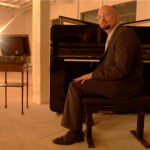While today “melancholy” simply means being sad, it used to mean a variety of introspective attitudes and, as they were called back then, humors. Artists were thought to be melancholic to begin with, and sometimes they studied their condition in order to chase away the blues. “I write of melancholy, by being busy to avoid melancholy,” wrote Robert Burton in his vast 1621 tome The Anatomy of Melancholy.
Another version of melancholy was the contemplation of transience: “All is vanity” or mVanitas. Leading “authentic instrument” keyboardist Andreas Staier’s liner note for his latest disc …pour passer la mélancolie explains further:
“My programme is devoted to musical representations of Vanitas in seventeenth-century France and Germany. The tombeau (tomb) and the plainte (lament) are typical genres… Gently broken chords, the melody that pauses, hesitates, then disappears, were from the first closely related to the affect of the lament… Suspension of… the pulse, already take[s] this music close to the memento mori in its style of writing. Meditative spaces open up, symbolising silence, emptiness, or solitude; funeral bells toll. Conversely, regular movement often represents the passing of time, the flow and trickling away of water as of life, or the solemn tread of the pompe funèbre… The ostinato conception of the frequent chaconnes and passacaglias may readily be understood as a symbol of ineluctable fatality. Even the sound of a single note on the harpsichord as it decays can remind one of the transience of all earthly things. This was what the Antwerp harpsichord builder Andreas Ruckers meant when he placed on several of his instruments the inscription Sic transit gloria mundi.”
However, when listening to this superb album, a powerful irony becomes evident: All was not vanity. Froberger, D’Anglebert, Fischer, Couperin, Clérambault, and Muffat lived their lives, wrote some music, died, and were forgotten for hundreds of years; but then, relatively recently, they were rediscovered, excavated, studied, and recorded. Indeed, one wonders when this music was at its best. Was the time of conception most alluring, when it was played in small rooms by a few amateurs on local instruments? Or does this warmly recorded, passionately performed and handsomely packaged album give this music its most compelling presentation yet? Certainly the sound and presence of the harpsichord can never be as immediate live as it is can be on record, unless perhaps one lies directly underneath the instrument.
Staier is a recent discovery for me; he is also my latest musical crush. I’m still finding my way around in his prolific discography, but it is already clear that no matter who he is playing or whatever his instrument, Staier stamps each interpretation as unquestionably his own. Two fortepiano records are particularly striking: the Beethoven Diabelli Variations shocks with exotic colors (including an outlandish “Janissary Band” effect, which you can hear Staier using here); the Mozart sonatas entertain with bouncing groove and fanciful ornamentation.
The repertoire on …pour passer la mélancolie is less familiar than Beethoven or Mozart partly because, for a long time, no one had any idea how to play it. In the heyday of later, fully-notated classical scores, most pre-Bach composers languished in comparative obscurity. What’s become known as “early music” documents a transitional period for the European tradition: Composers were putting notes and rhythms on a page but — at least compared to, say, Beethoven’s scores — they remained sketches and guides requiring improvisation and imagination, often remaining vague even about instrumentation. To play pre- or early Baroque repertoire in the contemporary era requires substantial academic study and much intuitive guesswork. Only in the last 50 or 60 years have there been musicians interested enough to take on the challenge. Momentum has kept building, and at this moment, “historically informed performance practice” is one of the most exciting aspects of the current classical landscape.
For his melancholy program, Staier’s interpretive choices come straight from the kind of details he enumerates in his sleeve note. The melodies start, stop, and sigh; the more dissonant rolled chords look into the abyss. Cascades of (possibly improvised?) trills and other florid ornaments wander over a constantly de-synchronized bass. Even occasional dance rhythms move forward and backward in speed, as if unsure whether the dance is worth continuing.
As compared to modern concert pitch where A=440 or higher, this pitch is A=405, so a C major chord sounds closer to B major. And forget the “well-tempered keyboard” consecrated by J.S. Bach: Staier’s harpsichord temperament is “after Lambert Chaumont, 1695.” To modern ears, this means harmonies get more “out of tune” the further away they are from white keys. Rather than being a detriment, this light and shade helps the most distant, black-key harmonies become more impassioned and vocal, at times almost suggesting an avant-garde blues.
Every work on the album is a treasure, but for now I’ll single out two works: Jean-Henry D’Anglebert’s “Fugue grave pour l’Orgue” and the first movement of Louis-Nicolas Clérambault’s Suite in C minor, “Prélude.” The D’Anglebert fugue is messy, absurdly over-ornamented, hyper-chromatic, and hypnotic. The Clérambault prelude uses a startling stop on the harpsichord (surely Staier’s own idea) that is as dry as a skeleton rattling in the graveyard wind — that is, if the skeleton had fluid melodic genius and perfectly executed trills, of course.
A man touches a harpsichord, and voices from four centuries ago speak and sing.






